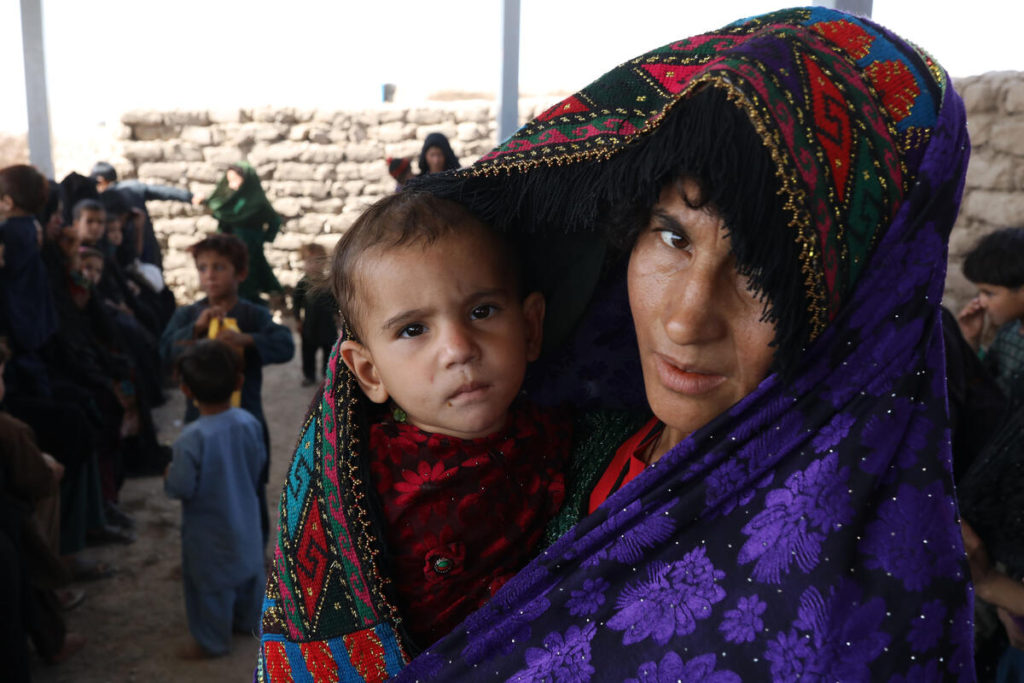Rome/New York, October 25 – Years of conflict, drought, economic woes and the recent accumulation of Covid-19 health problems have made Afghanistan home to one of the world’s largest number of people – nearly 23 million – facing severe humanitarian crisis as the harsh winter is approaching while funding available is “a drop in the ocean,” two United Nations agencies said as they launched an urgent appeal for help.
The Food and Agriculture Organization (FAO) and the World Food Program (WFP) said the 23 million Afghans facing dire malnutrition and hunger, including 3.2 million children under five, represented more than half of the country’s population. Globally, the affected Afghan population have needs surpassing those in Ethiopia, South Sudan, Syria and Yemen combined.
“It is urgent that we act efficiently and effectively to speed up and scale up our delivery in Afghanistan before winter cuts off a large part of the country, with millions of people – including farmers, women, young children and the elderly – going hungry in the freezing winter. It is a matter of life or death. We cannot wait and see humanitarian disasters unfolding in front of us – it is unacceptable!” said Qu Dongyu, FAO Director-General.
“Afghanistan is now among the world’s worst humanitarian crises – if not the worst – and food security has all but collapsed. This winter, millions of Afghans will be forced to choose between migration and starvation unless we can step up our life-saving assistance, and unless the economy can be resuscitated. We are on a countdown to catastrophe and if we don’t act now, we will have a total disaster on our hands,” said David Beasley, WFP Executive Director.
“Hunger is rising and children are dying. We can’t feed people on promises – funding commitments must turn into hard cash, and the international community must come together to address this crisis, which is fast spinning out of control,” Beasley warned. WFP said it expects operations to cost as much as US$ 220 million a month.
The two UN agencies said in their Integrated Food Security Phase Classification (IPC) report that more than one in two Afghans will be facing crisis (IPC Phase 3) or emergency (IPC Phase 4) levels of acute food insecurity through the November 2021 to March 2022 lean season, requiring urgent humanitarian interventions to meet basic food needs, protect livelihoods and prevent a humanitarian catastrophe.
The report also notes that this is the highest number of acutely food insecure people ever recorded in the 10 years the UN has been conducting IPC analyses in Afghanistan. Globally, Afghanistan is home to one of the largest number of people in acute food insecurity in both absolute and relative terms.
Following is part of the joint WFP-FAO news release:
Hunger spreads from rural to urban areas
The IPC report reflects a 37 percent increase in the number of Afghans facing acute hunger since the last assessment issued in April 2021. Among those at risk are 3.2 million children under-five who are expected to suffer from acute malnutrition by the end of the year. In October, WFP and UNICEF warned that one million children were at risk of dying from severe acute malnutrition without immediate life-saving treatment.
For the first time, urban residents are suffering from food insecurity at similar rates to rural communities, marking the shifting face of hunger in the country. Rampant unemployment and the liquidity crisis mean that all major urban centres are projected to face Emergency (IPC Phase 4) levels of food insecurity, including formerly middle-class populations.
In rural areas, the severe impact of the second drought in four years continues to impact the livelihoods of 7.3 million people who rely on agriculture and livestock to survive.
Current funding a drop in the ocean
FAO and WFP have been alerting the world to huge funding shortfalls and the need for urgent action by the international community before it is too late. Immediate financial support is now crucial to meet the most basic humanitarian needs as Afghans confront winter with no jobs, cash, or prospects, just as another La Niña event is on the horizon, meaning this year’s drought conditions are likely to extend into 2022.
To meet the scale of needs, the UN will need to mobilize resources at unprecedented levels. The UN’s Humanitarian Response Plan remains only a third funded. WFP in planning to ramp up its humanitarian assistance as we enter 2022 to meet the food and nutrition needs of almost 23 million people in Afghanistan. To meet the task at hand WFP may require as much as US$ 220 million per month.
Since the beginning of 2021, WFP has provided food, cash, and nutrition assistance to 10.3 million people, including malnutrition treatment and prevention programmes for nearly 400 000 pregnant and breastfeeding women, and 790 000 children under-five.
FAO continues to deliver vital emergency livelihood interventions at scale in Afghanistan, providing lifesaving support and cash assistance to farmers and livestock owning households who comprise 70 percent of the total population, so they can remain productive. More than 3.5 million people will be supported this year, with FAO reaching over more than 330 000 in August and September alone
Amid worsening drought, FAO is seeking $11.4 million in urgent funding for its humanitarian response and is seeking a further $200 million for the agricultural season into 2022. FAO is now distributing wheat cultivation packages, including high quality and locally-supplied seeds, fertilizers and training. This campaign is expected to benefit 1.3 million people across 27 out of 34 provinces of the country in the coming weeks.
IPC Report brief can be accessed here & IPC Snapshot here.
United Nations correspondent journalists – United Nations correspondent journalists – United Nations correspondent journalists
United Nations journalism articles – United Nations journalism articles – United Nations journalism articles

